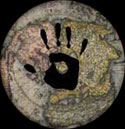Navigation
Home
FAQs
Descendancies
Famous Helenas
Links
About this page
|
Frequently Asked Questions (FAQ)
(The first 7 questions come from Oxford Ancestors.)
Click here for more FAQs from Oxford Ancestors.
- What is a DNA sequence? Your mitochondrial DNA sequence was prepared from the cheek cell sample that you supplied and details of the process that we used can be found on the sheet titled "How we did it". As you can see, your DNA sequence consists of a long series of four different letters: A, C, G, and T. These letters are shorthand for the four different chemicals that are strung together to make the long chain we know as DNA. The exact order in which these letters occur is a code that tells our cells how to divide, and how to grow into a human and how to perform the many different tasks required of them.
We have only read a small part of your DNA, four hundred letters to be exact. The total length of the DNA message is much, much longer; about 3,000 million letters longer, in fact, and these billions of letters are what make up your genome.
- Why do you read the mitochondrial DNA? DNA is passed on to the next generation in sperm and eggs. Mitochondrial DNA (mtDNA, for short) is special because it is only passed on through the egg. This means that everyone has inherited their mtDNA from their mother. She inherited it from her mother, who inherited it from her mother, who inherited it from hers - and so on back through time. Therefore, mtDNA provides a direct link to our maternal ancestors. We all inherit other genes from many other ancestors, but only mtDNA traces a direct maternal line.
- How do you compare my DNA sequence? Your mtDNA sequence, which is printed below your chart, is the DNA sequence that has been passed on to you with little or no change from your remote female ancestors. Think of it as a very long word with four hundred letters. To compare the distinct spellings that we find in different people, we use what we call a reference sequence, actually the most frequent sequence found in Europe. Where your sequence differs from the reference 'spelling', we have picked-out the letters in red. If there are no red letters, then your mtDNA sequence is identical to the reference sequence. [That's us!!!]
- Why does DNA change over time? When cells divide, the DNA that they contain has to be copied. Fortunately, this is an extremely accurate process and mistakes occur only very rarely. When they do, however, they are called mutations. If they happen in a gene responsible for an important cell function, they can give rise to severe inherited diseases, like cystic fibrosis or muscular dystrophy. However, the great majority of mutations occur without having any obvious effect at all. Mutations in the section of mtDNA that we sequenced are of no consequence to your health, but they are extremely useful for studying our ancestry. This is because, on average, one mutation occurs in mtDNA every twenty thousand years!
- How do I interpret my DNA chart? The chart that you have received is made up of interconnecting circles of different sizes. Each of these circles represents a DNA sequence found in Europe and their sizes reflect the appropriate number of people who have that particular sequence. The bigger the circle, the more people have the sequence that it represents. For example, the large pale blue circle represents the most frequent mtDNA sequence found in Europe. [That's us again!] It is also the reference sequence with which we compare all the others. The details of the chart have been worked out in Oxford using over 13,000 sequences from people living all over the world.
The lines connecting the circles trace the evolutionary pathways of our ancestors. The length of each line depends on the number of changes (mutations) between the two circles it connects and most of them represent only a single change out of the 400 DNA letters that we read.
The largest of the grey circles near the top-centre of the chart represents the sequence that connects the Seven Daughters of Eve chart to the rest of the world, through the dashed line. Like the other grey circles, we have not yet found this particular DNA sequence in any living person, but we know from our reconstructions that it must have existed.
- How does my DNA fit into the chart? The golden star shows the chart position of your own sequence. It belongs to one of the seven different groups or clans, each shown by a different colour. The members of each clan are all descended from a single female ancestor through the direct maternal line traced on the chart. We call these women "The Seven Daughters of Eve". From your DNA sequence we are able to tell to which clan you belong and which of these seven women is your maternal ancestor.
- Who were the Seven Daughters of Eve? It is an entirely logical, yet still awe-inspiring fact, that we are all related to each other through our mothers. Over the past ten years, research by Professor Bryan Sykes at Oxford University has identified just seven women, who lived thousands of years ago, from whom almost every native European is directly descended through the maternal line. Professor Sykes has calculated approximately how long ago these women lived and even estimated their whereabouts. We know they survived and that each had daughters, starting off lines of descent that reach right down to all of us living today. These were real people, real women who brought up families, but who lived in very different circumstances to those that we enjoy today. These really were our true ancestors. We have given them names and here are their stories... [Refer back to the Home Page for the story on Helena.]
|


